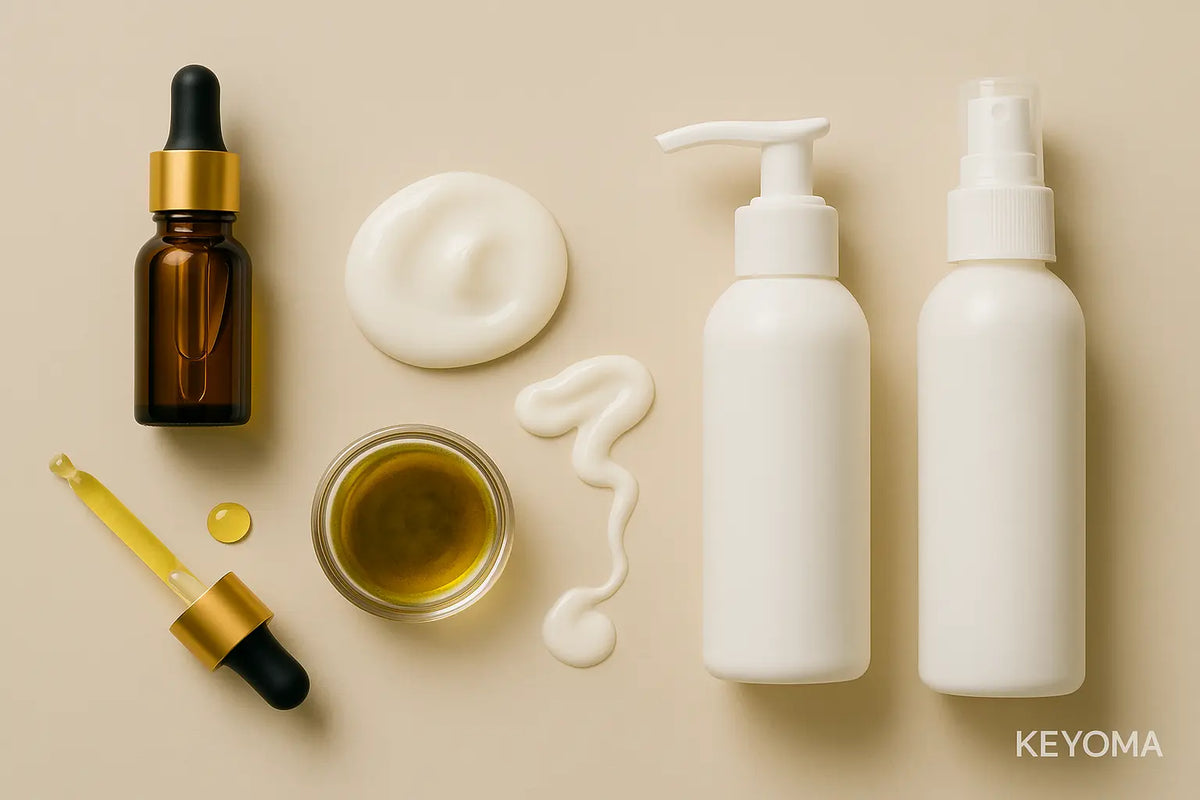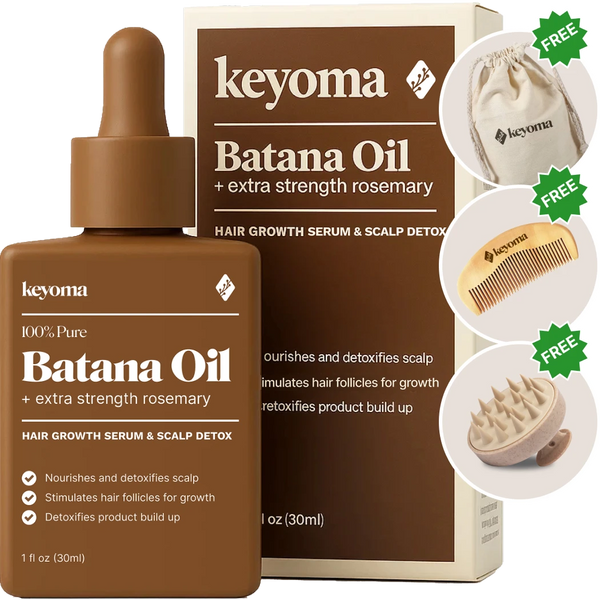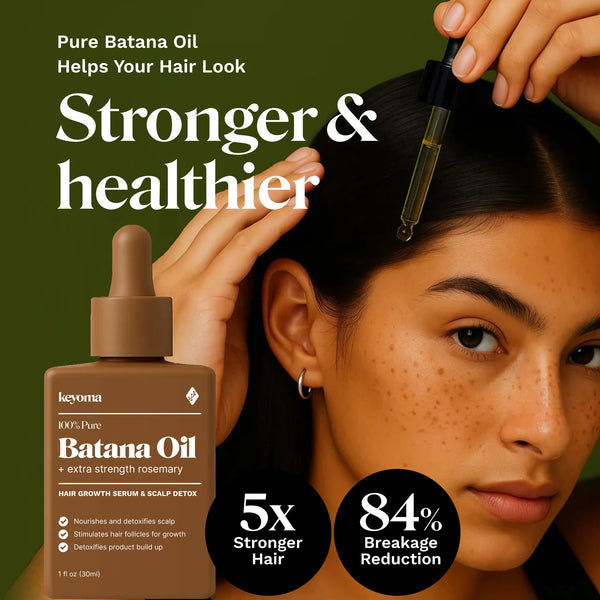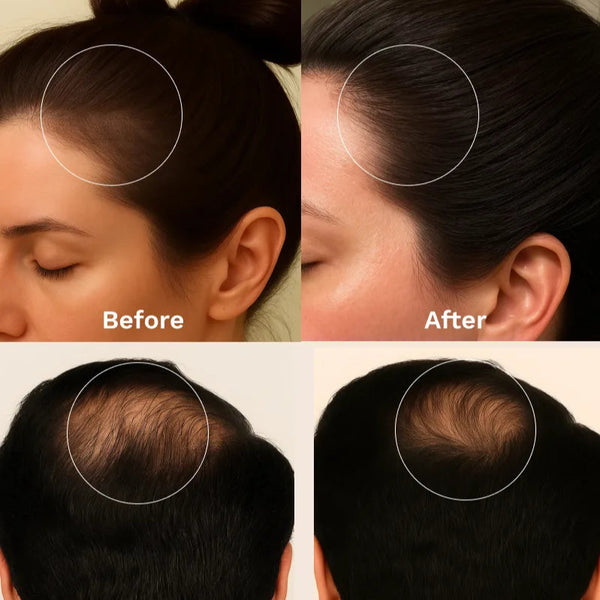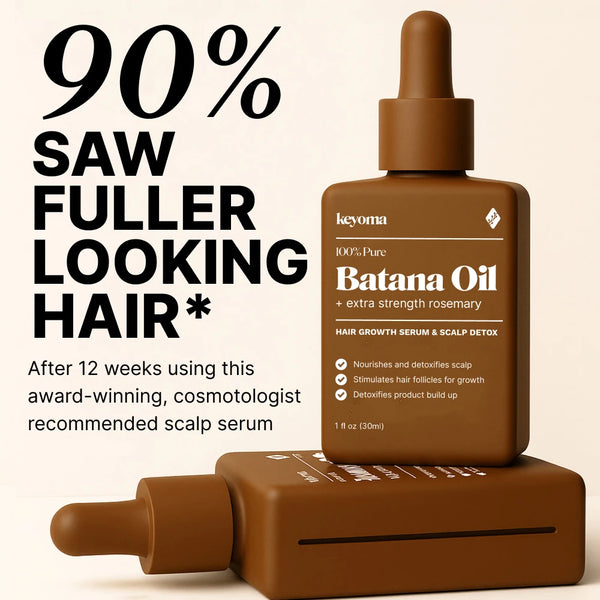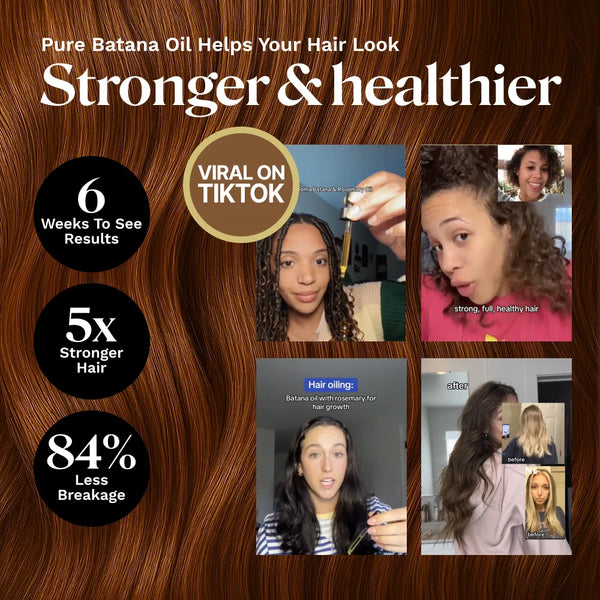In this article
When it comes to what to put on your hair after washing, two products usually come to the forefront: hair serum and leave-in conditioner. Both are designed to stay in your hair, and both sound like they could do the same thing—and it doesn’t help that they can look quite similar at first glance.
They share some overlap, yet their purposes are different enough that using them the wrong way can leave you with limp, greasy strands or still-frizzy ends.
That’s why in this guide, I’ll walk you through what each one does, how they differ, and how to layer them together for the best results.
Quick Takeaways
-
Hair serum adds shine and controls frizz on the surface, best for times you want a quick polished look before heading out or styling.
-
Leave-in conditioner gives moisture and easy detangling, best for when your hair feels dry, rough, or hard to manage after washing.
-
The best results come from using both together in order: Leave-in conditioner first, hair serum after.
Hair Serum vs Leave-In Conditioner Quick Side-by-Side Comparison
To make things simpler, here’s a quick table that lines up the two side by side. You’ll see how they differ in purpose, texture, and best uses.
|
Feature |
Hair Serum |
Leave‑In Conditioner |
|
Purpose |
Quick shine, frizz control, polish |
Moisture, detangle, protect |
|
Works best for |
Frizz, humidity flyaways, sleek looks |
Dryness, knots, heat styling preparation |
|
Texture |
Slick/oily, silky liquid |
Light cream, lotion, or spray |
|
Key ingredients |
Largely silicones plus natural oils and plant extracts |
Water-based, with humectants and emollients |
|
When to use |
Dry/mostly dry hair, finish |
Damp hair after wash |
|
How much to apply |
Pea‑size for medium hair |
Dime to quarter coin size |
|
Risks |
Can look greasy if overused |
Can feel heavy if overapplied |
What is a Hair Serum?

Hair serum is a lightweight, silicone or oil‑based styling product designed to coat the surface of your hair. Its main purpose is to add shine, smooth frizz, and protect strands from external stressors like humidity and heat.
It’s best used when you want an instant polished finish rather than long‑term moisture repair.
Texture
Most serums have a slick, liquid texture that feels silky between your fingers. They glide easily on hair, coat strands evenly, and don’t need to be rinsed out.
Ingredients
Hair serums usually include silicones (like dimethicone) for smoothing, natural oils such as argan or jojoba for shine, and plant extracts or proteins that protect against breakage and dryness.
Something worth mentioning when it comes to hair serum ingredients is the emergence of bee venom in certain formulations. I’ve actually dug into the research on bee venom, and it looks really promising for hair health.
On top of that, some—but not all—formulas also include UV filters or heat protectants. These are especially useful if you spend a lot of time in the sun or frequently use high-heat styling tools, both of which can weaken strands and fade color.
Benefits
Beyond the surface-level effects that make hair look good on the outside, serums also work through specific ingredients that interact with the cuticle and outer layer of your strands, paving the way for these benefits:
-
Adds shine: Silicones and certain natural oils form a thin reflective layer around each strand, which catches the light and makes hair look glossy.
-
Controls frizz: Silicone polymers and plant oils seal the cuticle so that outside humidity can’t penetrate as easily, reducing puffiness and static.
-
Shields from environmental and heat damage: Antioxidants, UV filters, and film‑forming agents shield the hair shaft from pollution, heat styling, and sun exposure, slowing down wear and tear.
-
Defines styles: The coating action smooths the cuticle and helps individual strands align, which keeps flyaways flat and allows curls or waves to hold their shape.
Disadvantages of Hair Serum
Some hair serums rely heavily on silicones, and these thicker formulas can sometimes coat strands too much, leaving them flat or lifeless. But the bigger issue, I would argue, isn’t the presence of silicone itself. It’s when the product is applied too generously or too often.
That's to say excess use can weigh hair down or make it appear greasy, especially for fine or oily hair, and may also create buildup if not washed out regularly.
Many serums and leave-ins also don’t protect from hot tools unless the label specifically claims it.
Application / How to Use Hair Serum
Hair serum is most effective after washing and conditioning, when hair is still slightly damp and the cuticle is ready to be smoothed, but you can also use it on dry hair when you want to refresh shine or tame flyaways.
In terms of how often to apply hair serum, most people use it two to three times a week, though you can apply it daily if your hair is especially dry or exposed to heat and pollution.
Below are the steps to effectively apply it on your hair:
Step 1: Wash your hair as usual and towel‑dry until it’s slightly damp. You can also apply serum on dry hair for finishing.
Step 2: Dispense a pea‑sized amount for short to medium hair, or two pea‑sized drops for longer or very thick hair.
Step 3: Rub the serum between your palms to spread it evenly.
Step 4: Starting from the mid‑lengths, smooth your hands down to the ends. Focus on areas that tend to frizz or look dull.
Step 5: Comb through with your fingers or a wide‑tooth comb to distribute the product.
Step 6: Avoid applying directly to the scalp to prevent greasiness.
Step 7: Reapply a tiny drop only when hair starts to look frizzy or loses shine.
What is a Leave-In Conditioner?

A leave-in conditioner is a creamy, lotion-like product designed to hydrate and soften your hair. It helps with detangling, keeps dryness at bay between wash days, and works on moisture repair rather than just styling.
This is different from a regular rinse-out conditioner, which you wash away after a few minutes in the shower. A leave-in is meant to stay in your hair, allowing its humectants, emollients, and conditioning agents to keep working long after you step out of the bathroom.
That said, it repairs moisture levels while also prepping your hair to be easier to style and less prone to breakage.
It’s also fairly common to confuse leave-in conditioner with hair oils since both are applied after washing. But here’s the key difference. Leave-ins directly restore moisture balance, while oils mainly seal in the moisture that’s already there.
These two aren't competition. On the contrary, they actually work best together. I’d say it’s a little like comparing leave-in conditioners with serums. Each has a different function, and when paired, the results are even better (but more on that later!).
Texture
Leave-in conditioners usually come as a light cream, lotion, or spray. The creamy or milky consistency makes them glide through damp strands without leaving an oily film, which is why they’re ideal for detangling and hydrating rather than just finishing shine.
Ingredients
Most leave-in conditioners are water-based and include humectants such as glycerin or aloe vera that pull moisture into the hair shaft.
They also contain emollients like natural oils or fatty alcohols to soften strands, and conditioning agents such as quaternary ammonium compounds that smooth the cuticle and reduce static.
Some leave-in conditioners list proteins like hydrolyzed keratin or silk right on their labels. These are added to reinforce weak areas of the hair shaft and improve elasticity.
Benefits of Leave-Ins
Leave-in conditioners provide ongoing support for your strands beyond the shower:
-
Hydrates all day: Humectants like glycerin and aloe draw water into the hair shaft, keeping strands from drying out between washes.
-
Softens and smooths: Emollients such as fatty alcohols and natural oils coat the cuticle, giving hair a softer touch and reducing roughness.
-
Eases detangling: Conditioning agents (like quats) and lightweight silicones add slip, which helps combs glide through knots with less breakage.
-
Strengthens weak spots: Formulas with added proteins such as hydrolyzed keratin fill in gaps in damaged strands, improving elasticity and reducing snap.
-
Preps for styling: By balancing moisture and smoothing the cuticle, leave-ins make hair more manageable for heat styling or protective styles.
Disadvantages of Leave-In Conditioner
One of the most common concerns people ask is, “Does leave-in conditioner make hair look greasy?” The short answer is yes—if it’s overapplied or if the formula is too rich for your hair type.
Like I said earlier, it all comes down to proper application. This is especially true for fine or thin hair, which can feel weighed down if too much product is used.
Other disadvantages include the risk of buildup from certain conditioning polymers or silicones if you don’t wash regularly, and the chance of flattening natural volume if you already have oily roots.
Heavier formulas may also interfere with styling hold, especially for those who use gels or mousses.
And just like serums, leave-ins only protect from heat if the label specifically says so. Without that claim, you’ll still need a dedicated heat protectant.
How to Correctly Apply Leave-In Conditioner
A leave-in conditioner works best when you put it on freshly washed, damp hair because that’s when the cuticle is open and ready to absorb moisture. Using it on dry hair won’t hurt, but you’ll get far less hydration.
Here’s the exact order of application and how much to use:
Step 1: Wash and condition your hair as usual, then gently towel-dry until damp.
Step 2: Dispense a nickel-sized amount of cream leave-in (or 5–8 sprays if using a mist). Adjust to half that amount if you have fine or short hair, and more if your hair is very thick or long.
Step 3: Rub the product between your palms (for cream types) or spray directly onto sections (for spray types).
Step 4: Apply evenly from mid-lengths to ends, focusing on drier areas that need extra hydration.
Step 5: Comb through with fingers or a wide-tooth comb to distribute.
` Style as usual. Reapply only small amounts between wash days if hair feels dry.
Can I Use Leave-In Conditioner and Serum Together Without My Hair Getting Greasy?
Absolutely! In fact, I’d say using leave-in conditioner and hair serum together gives better results than choosing one over the other, so long as you apply them in the right order and amount.
When layered correctly, the leave-in conditioner hydrates and softens, while the serum seals the cuticle and adds shine. The result is hair that feels nourished, manageable, and polished.
Here’s how to layer them into your routine:
Step 1. Wash and towel-blot to damp.
After shampooing and conditioning as usual, gently squeeze out excess water with a microfiber towel.. The goal is to leave your roots about 60–70% dry and your lengths around 40–50% damp.
Step 2. Detangle and Section the Hair.
Using a wide-tooth comb or a detangling brush, start combing from the ends and work your way up to remove tangles without breakage. Separate your hair into two to four sections with clips, depending on density and curl type.
Step 3. Apply Leave-in Conditioner.
Take a small amount of leave-in conditioner—pea to dime size for fine or short hair, nickel size for medium or shoulder-length hair, and up to quarter size for thick, long, or coarse hair.
Emulsify it between your palms, then apply from the mid-lengths down to the ends, keeping at least two fingers’ distance from the scalp.
For straight or wavy hair, rake it through with your fingers and follow with a comb. For curly or coily hair, glaze it over each section using the praying-hands method, then define curls with a Denman brush or scrunch.
If your hair starts to feel dry while applying, mist it lightly with water to re-dampen. Allow the product to absorb for about a minute.
Step 4. Seal and Smooth With Hair Serum.
Warm one to two drops (for fine hair) or up to a pump (for medium to coarse hair) of serum between your palms until it feels lightweight. Start by applying it to the ends, then glide it over the outer canopy of your hair using the praying-hands technique.
Avoid the roots and scalp, since that’s where product buildup shows first.
If your hair is thick or coarse, you can use slightly more, but it’s always better to start small and add more later if needed.
And to really emphasize this point: always keep at least a two-finger buffer from your scalp when applying leave-in or serum to avoid greasiness. Focus product on the mid-lengths and especially the bottom third of your hair.
Step 5. Protect From Heat and Dry.
As mentioned earlier, not all serums automatically include UV filters or heat protection. That’s why if you plan to use a blow dryer, flat iron, or curling tool, it’s important to apply a light mist of dedicated heat protectant at this stage. This extra step helps shield your strands from direct heat damage.
Step 6. Finish and Polish.
Once your hair is dry, take just half a drop of serum on your fingertips. Rub it in lightly, then tap down any flyaways or twist it into the driest ends for extra smoothness. If you’re working with curls, this is also the time to scrunch out any cast that formed during drying.
Which Works Better Based on Hair Type
Leave-in Conditioner or Hair Serum for Fine or Oily Hair
Fine or oily hair tends to look flat when heavy products are used. In this case, a lightweight serum works better because silicones and oils can smooth frizz without weighing strands down.
If you want hydration from a leave-in, stick to a spray formula and use a very small amount.
Hair Serum vs Leave-In Conditioner for Curly Hair
Curly hair needs plenty of moisture to stay soft, but it also needs products that help define the curl pattern so it doesn’t look puffy or shapeless. Leave-in conditioner is usually the first choice because humectants and emollients hydrate the curl pattern, making it softer and less prone to breakage.
Serum can be layered afterward to lock in that moisture and give curls a polished finish.
Leave-in Conditioner or Serum for Frizzy Hair
Frizz often comes from raised cuticles and external humidity. A leave-in conditioner helps by keeping strands hydrated from the inside, while a serum seals the outside to block excess moisture from the air.
For really stubborn frizz, I strongly suggest you use both. Put leave-in conditioner first for moisture, serum second for a smooth barrier.
Frequently Asked Questions (FAQs)
When to use hair serum vs conditioner?
Use a hair serum when you want quick shine, polish, and frizz control. On the other hand, reach for a leave-in conditioner when you need deeper hydration and moisture, especially if your hair feels tangled, brittle, or rough to the touch. Ideally, you should use both for the best results for your hair.
Is hair serum a leave-in conditioner?
No. A hair serum is a styling product, not a conditioner. Serums mainly add shine and smoothness by coating the hair surface, while leave-in conditioners hydrate, soften, and strengthen from within.
Is it bad to use leave-in conditioner every day?
Not necessarily. Daily use is safe if the product is lightweight and suits your hair type. Overusing heavy leave-ins, however, can cause buildup, greasiness, or weigh hair down, especially on fine strands.
Can I skip conditioner and use leave-in conditioner?
You can, but it’s not ideal. Rinse-out conditioners are meant to balance pH and smooth the cuticle after shampooing. Leave-ins, on the other hand, are best as an extra layer of moisture and protection and not a complete replacement.
Should I apply leave-in conditioner or hair oil first?
Apply leave-in conditioner first, then hair oil. Leave-ins pull moisture into the hair, while oils mainly lock in what’s already there. Reversing the order prevents the leave-in from penetrating effectively.
What's the difference between hair oil, serum, and conditioner?
Hair oil is usually natural oil that nourishes and seals moisture. Hair serum is often silicone or oil-based and designed for shine, frizz control, and protection. Leave-in conditioner is water-based and built for hydration, detangling, and strengthening.
Why Choose One When You Can Use Both?
Hair serum gives you shine, frizz control, and surface protection, while leave-in conditioner gives you moisture, softness, and easier styling.
Each one serves a different role, but the real magic happens when you use both—that’s how you get hair that not only looks healthy but also makes you feel more confident stepping out the door.
If you’re considering serum, I recommend looking into options that go beyond silicones, like those with bee venom or nourishing oils such as batana or jojoba.
For leave-ins, a clean, lightweight formula with aloe or glycerin is a safe bet, especially if you prefer non-toxic hair care.
Featured Product
100% Pure Batana Oil + Rosemary
↓Best Batana Oil to Buy↓
1 Month
Subscribe & Save
- 30-day supply delivered monthly $35
- 30% off for life $6
- Free haircare essentials kit $33
- Free custom wooden comb $10
- Free scalp massager $15
- Free eco-friendly travel bag $8
- 30-Day Money Back Guarantee
- Free Shipping
- Online portal for easy cancel, skip, or pause.
1 Month One Time Purchase
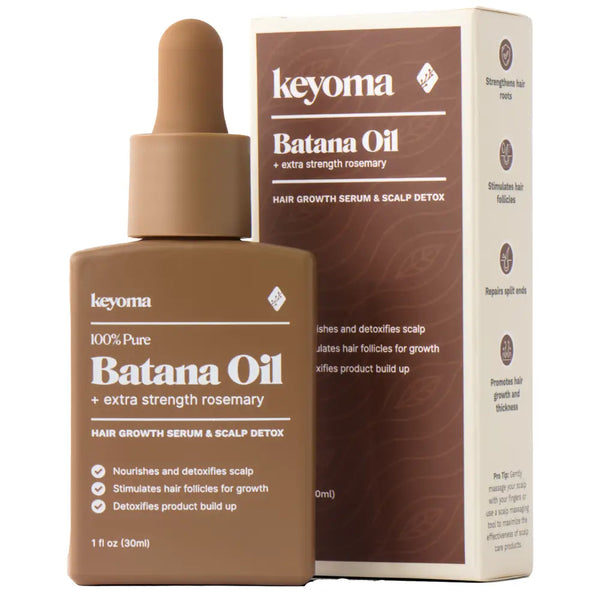
- 30-day supply $50
- 30% off for life $6
- Free haircare essentials kit $33
- Free custom wooden comb $10
- Free scalp massager $15
- Free eco-friendly travel bag $8

